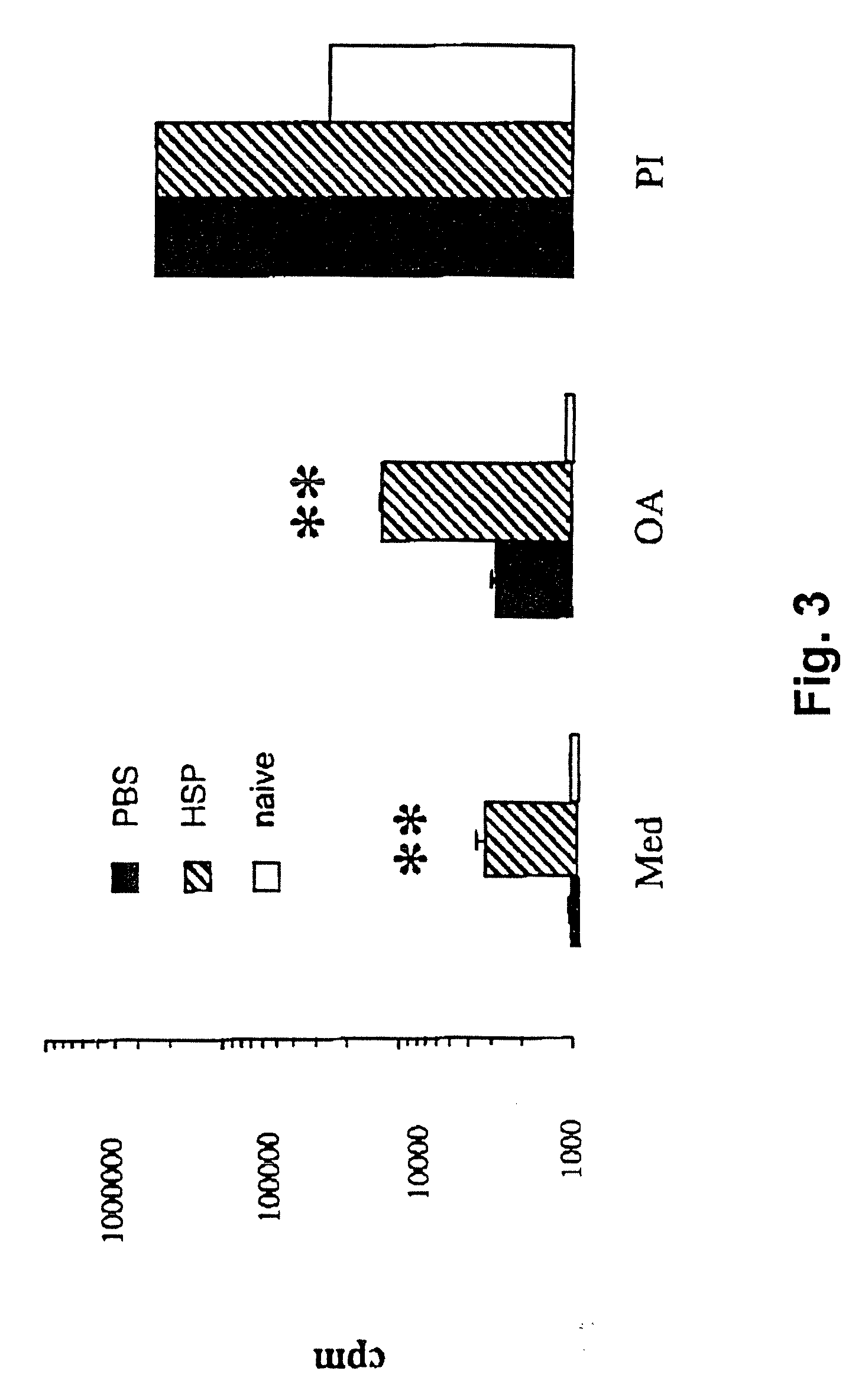Method for treating inflammatory diseases using heat shock proteins
a technology of inflammatory diseases and proteins, applied in the direction of aerosol delivery, immunological disorders, drug compositions, etc., can solve the problems of affecting etc., to improve the fev1 of the mammal, reduce the airway methacholine responsiveness, and improve the fev1
- Summary
- Abstract
- Description
- Claims
- Application Information
AI Technical Summary
Benefits of technology
Problems solved by technology
Method used
Image
Examples
example 1
[0097] The following example demonstrates that mycobacterial heat shock protein-65 (HSP-65) upregulated T cell proliferative responses in a mouse model of airway hyperresponsiveness following short term sensitization with ovalbuimin in alum.
[0098] Animal models of disease are invaluable to provide evidence to support a hypothesis or justify human experiments. Mice have many proteins which share greater than 90% homology with corresponding human proteins. For the following experiments, the present inventors have used an antigen-driven murine system that is characterized by an immune (IgE) response, a dependence on a Th2-type response, and an eosinophil response. The model is characterized by both a marked and evolving hyperresponsiveness of the airways.
[0099] The development of a versatile murine system of chronic aeroantigen exposure, which is associated with profound eosinophilia and marked, persistent and progressive airway hyperresponsiveness, provides an unparalleled opportuni...
example 2
[0107] The following Example demonstrates that mycobacterial HSP-65 upregulated T cell proliferative responses in a mouse model of allergic sensitization following suboptimal sensitization with ovalbumin via aerosol challenges.
[0108] Since immunization of mice with mycobacterial HSP-65 enhanced T cell responses to OA following i.p. sensitization of mice (Example 1), the question arose as to whether mycobacterial HSP-65 would upregulate responses under conditions in which antigen-specific T cell responses would normally not be detected (i.e., suboptimal sensitization with ovalbumin). Furthermore, the following experiment was designed to test how short term mycobacterial HSP-65-treatment would affect airway responses (bronchial alveolar lavage (BAL) cellularity and airway responses to methacholine challenge).
[0109] Mice were exposed to OA aerosol (1%) on days 1, 2, 3 and 6
[0110] (suboptimal protocol), and were injected with 100 μg mycobacterial HSP-65 or PBS, i.v., on day 1 and 6. ...
example 3
[0117] The following Example demonstrates that mycobacterial HSP-65 upregulated T cell proliferative responses in a mouse model of airway hyperresponsiveness following optimal sensitization and challenge with ovalbumin in alum.
[0118] In the mouse model of airway hyperresponsiveness and allergic sensitization used herein, it has been established that systemic sensitization and local airway challenges result in airway hyperresponsiveness (AHR) associated with eosinophilic inflammation of the airways, cardinal features of human asthma (See, for example, Bentley et al., 1992, Am. Rev. Respirr. Dis. 146:500-506; Houston et al., 1953, Thorax 8:207-213; or Dunhill, 1960, J. Clin. Pathol. 13:27-33; these publications being incorporated herein by reference in their entireties). In order to investigate the effects of mycobacterial HSP-65-treatment on these pathological changes of the airways, mice were sensitized intraperitoneally with 20 μg OA (Grade V, Sigma Chemical Co., St. Louis, Mo. to...
PUM
| Property | Measurement | Unit |
|---|---|---|
| concentration | aaaaa | aaaaa |
| concentration | aaaaa | aaaaa |
| body weight | aaaaa | aaaaa |
Abstract
Description
Claims
Application Information
 Login to View More
Login to View More - R&D
- Intellectual Property
- Life Sciences
- Materials
- Tech Scout
- Unparalleled Data Quality
- Higher Quality Content
- 60% Fewer Hallucinations
Browse by: Latest US Patents, China's latest patents, Technical Efficacy Thesaurus, Application Domain, Technology Topic, Popular Technical Reports.
© 2025 PatSnap. All rights reserved.Legal|Privacy policy|Modern Slavery Act Transparency Statement|Sitemap|About US| Contact US: help@patsnap.com



